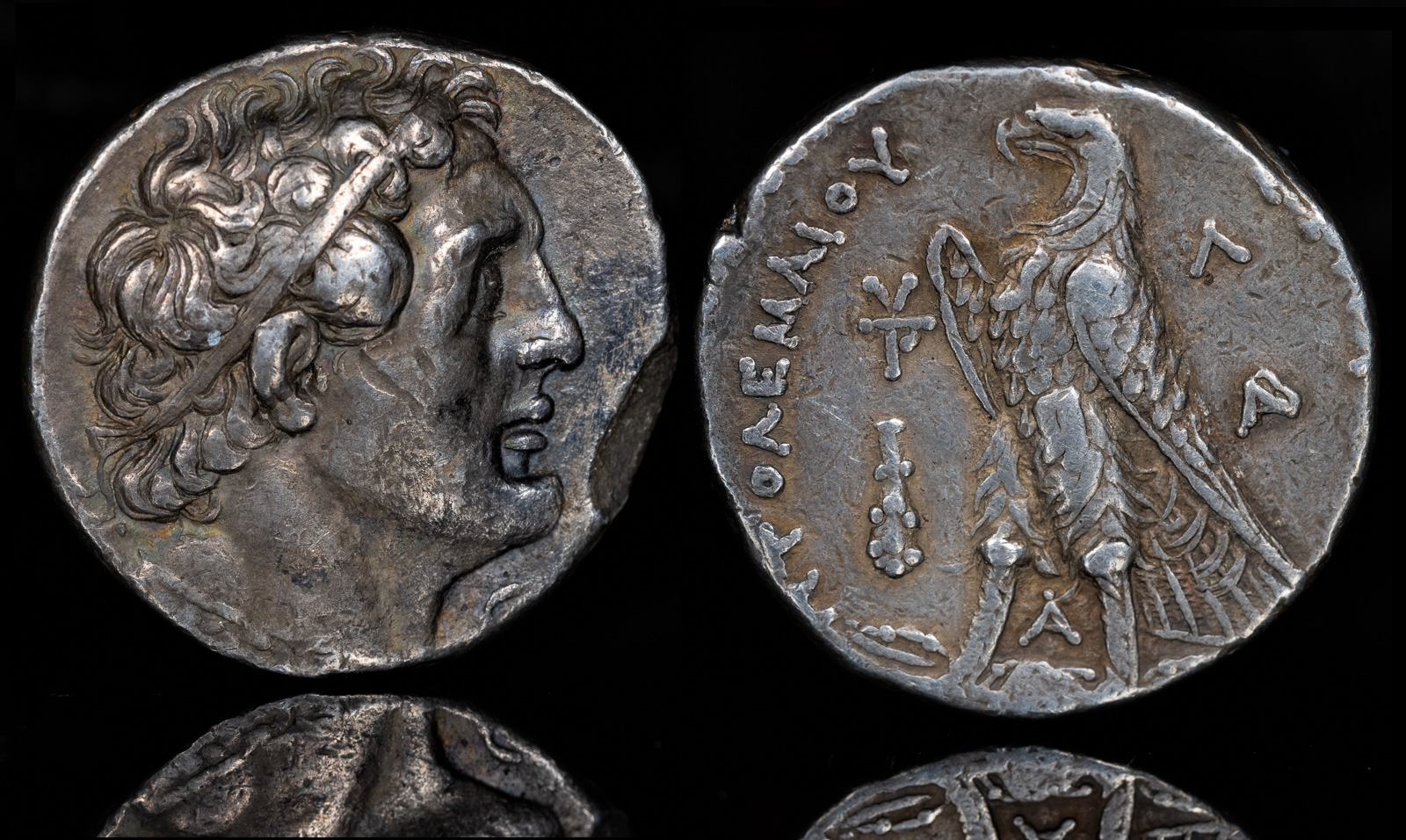
Kingdom of Macedon, Philip III Arrhidaios AR Tetradrachm
In the name and types of Alexander III
Struck under Menes, with Perdikkas as regent
Tyre, dated RY 29 of Azemilkos = 321/0 BC
Head of Herakles to right, wearing lion skin headdress / Zeus Aëtophoros seated to left, holding sceptre; ΑΛΕΞΑΝΔΡΟΥ to right, -|O (Phoenician ‘K = ‘Ozmilk [king of Tyre]) above ||| ||| =/||| (Phoenician date [29]) in left field.
Price 3275 (Ake); Newell, Dated 32 (same); DCA 737; HGC 3.1, 941 (Alexander IV). 17.03g, 26mm, 6h.
Entire books have been written on the history of Tyre. As one of the principal centers of Phoenician culture, it has a vast history that goes back thousands of years.
For the purpose of this site, though, we can focus on its siege by Alexander. The presence of the city was a major blocker for Alexander, and he was bitterly insulted when Azemilkos refused to capitulate. The entire siege involved a grueling nine months, when Alexander built a causeway that still stands to the island fortress and proceeded to assault it.

Ptolemaic Kingdom of Egypt, Ptolemy II Philadelphos
AR Tetradrachm. Tyre, dated RY 30 = 256/5 BCE
14.01g, 25mm, 12h.
Diademed head of Ptolemy I to right, wearing aegis around neck / ΠΤΟΛEΜΑΙOΥ [BAΣΙΛEΩΣ], eagle standing to left; monogram of Tyre above club to left; Λ (date) above monogram to right; A between legs.
CPE 577; Svoronos 657; SNG Copenhagen 488; DCA 20
Ex collection of R. N. Draskowski;
Ex Ephesus Numismatics, North Carolina, USA
The various kings of Cyprus lent their ships and it was eventually from the sea that Alexander was successful. Thereafter, he killed eight thousand citizens of Tyre and sold another thirty thousand into slavery. Azemilkos, however, was pardoned.
In 323 BCE, after Alexander’s death, Tyre was given to Laomedon. However, he didn’t keep it for long as Ptolemy soon conquered it. It was taken back by Antigonos I Monophthalmos in 315 BCE, where it remained until Ptolemy grabbed it back in 287 BCE.

Phoenicia. Tyre. ‘Uzzimilk
RY 10 = 340/39 BCE
Shekel Silver, 20 mm, 8.21 g, 12 h
Deity, holding reins in his right hand and bow in his left, riding hippocamp to right above two lines of waves; below, dolphin right.
Rev. Owl standing right, head facing; crook and flail in background; to right, date and ‘ (in Phoenician).
DCA 918. E&E-T 1146-8. HGC 10, 349
Ex collection of Dr. A. Drakul.
Ex Leu
Tyre is founded according to Herodotus. Some archeological data backs this up.
Tyre is under Egyptian control.
Tyre achieves independence from Egypt.
Hiram I becomes King of Tyre, leading the city to great prosperity.
Hiram I of Tyre aids in the construction of Solomon’s Temple in Jerusalem.
Presumed death of Hiram I of Tyre.
Much of Kition is rebuilt by settlers from Tyre.
Traditional founding date of Carthage by Phoenician settlers from Tyre, led by Queen Dido (according to legend).
The neo-assyrian king Shalmaneser V besieges Tyre.
Sidon is taken by the Assyrians after a siege, Abdi-Milkutti is decapitated and some of Sidon’s treasure is taken to Tyre.
The siege of Tyre by Nebuchadnezzar II is given up in failure.
September 26
Aegina plays a significant role in the Greek naval victory against the Persian Empire in the Battle of Salamis. Byblos, Arados, Tyre, Halikarnassos under Artemisia, Kos, and Sidon support Darius. Chalkis and Kythnos support the Greek effort. Alexander I serves as a peace negotiator on behalf of the Persians.
Artaxerxes III Okhos sends his satraps Belesys and Mazaios to retake Sidon, Tyre, and Byblos. The Persians are defeated by the Phoenicians, supported by Nektanebo II and Mentor of Rhodes.
Autophradates leads the Aegean fleet of Persia under the supreme command of Memnon of Rhodes. Azemilkos of Tyre accompanies him.
Androkles of Amathos, Pnytagoras of Salamis, and Pasikrates of Kourion join Alexander the Great at the Siege of Tyre, where their qinqueremes are destroyed.
Alexander the Great completes the Siege of Tyre. 6000 soldiers are killed in the city, 2000 Tyrians are crucified on the beach, and 30,000 are sold into slavery. Their leader Azemilkos is pardoned but deposed. Gerostratos of Arados presumably plays a part.
The flagships of Pnytagoras of Salamis, Androkles of Amathos, and Pasikrates of Kourion are destroyed while anchored in the harbor of Tyre.
Mallos gives ships to aid Alexander III in the Siege of Tyre.
Antigonos I Monophthalmos Declaration of Tyre grants autonomy to all Greek cities. While its effects weren’t the same everywhere, it allowed Delos to regain control of its Temple to Apollo from Athens.
Antigonos Monophthalmos besieges Tyre.
Tyre is taken by Antigonos Monophthalmos after a year.
Tyre becomes a republic.
Hannibal escapes to Tyre from the Romans.
Alexander Balas gives Tyre the right to asylum.
Demetrios II Nikator is defeated at the Battle of Damaskos by Alexander II Zabinas. He is then captured and killed on a ship near Tyre. Alexander II takes the Seleukid throne.
Tyre obtains its independence from the Seleukids.
Tyre adopts its own calendar.
Hadrian bestows Tyre with the title of Metropolis.